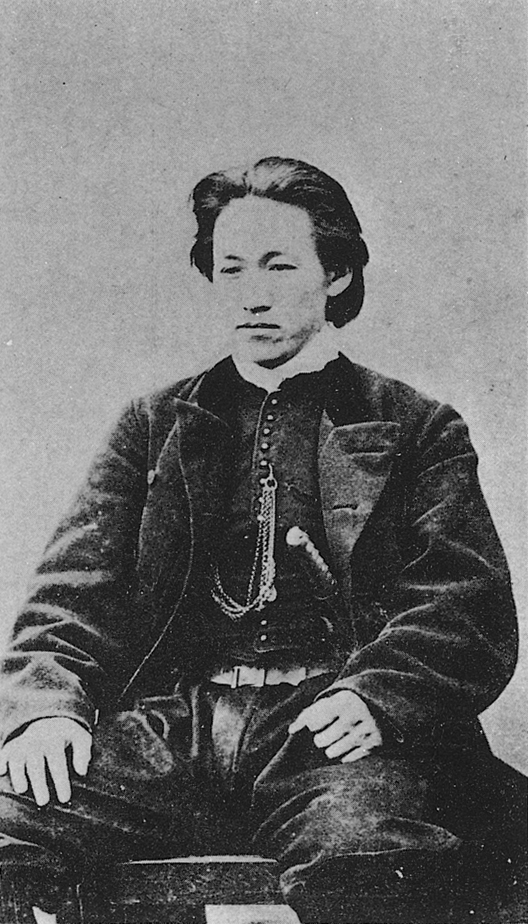

土方歳三 HIJIKATA Toshizo
1585 – 1869
The Last Handsome Samurai with Courageous Spirit
Medicine Peddler Boy Yearning to become a Samurai
Hijikata was born in 1835 in Musashi Province (Tokyo) as the youngest of 10 siblings. His home was very wealthy with a running drugstore, selling home-recipe-medicines. His father died of tuberculosis before Hijikata was born, and his mother also died from tuberculosis when Hijikata was six. Hijikata was raised by his second brother, Kiroku, and his wife, Naka. Although his life sounds very harsh from such a young age, Hijikata grew up healthy, and he was the boss of all the neighborhood kids as he was a courageous and active boy. Hijikata was smart and polite since he was a kid, and was longing to learn martial arts to become a samurai. Although he was the youngest of a large family, he had to start working at an early age. He worked for a kimono store when he was 11 years old and a cotton store after that. He worked well but ended up getting fired when he was 17 years old because he had gotten into many women-related troubles at work with his handsome appearance. After all, he decided to work at a drugstore at home, where he sold medicines and directed medicine-harvesting. His amazing leadership helped their job go faster and smoother. While Hijikata was living this life as an ordinary young guy who cut lawns and sold medicines, Edo was changing because of the arrival of the Black Ships from the U.S.
Recruit! Shogun’s Escort in Kyoto
At the age of 24, Hijikata entered the Dojo Center in Edo to train in swordplay. He met Kondo Isami (they became the best partner later) at the Dojo, and Hijikata revealed a talent for swordplay and got stronger and stronger during the daily training. At the time when Japan was under threats of foreign countries, there was a movement to fight hard to dispel foreign countries all around Japan, and people who were training at the Dojo had the passion for doing the best to fight for the Edo Shogunate. One day, the Dojo received the news that the country was looking for escorts for Shogun in Kyoto. As this would have been a great chance to become a samurai, Hijikata heads to Kyoto with the members of the Dojo, including Isami.
We are “Shinsengumi”
Hijikata started to serve for the Shogunate as a member of the group called “Mibu Roshigumi” when he was 28 years old. Isami and Serizawa Kamo, who came from another area, were the two leaders of the group. The first job requested by the Shogunate was to expel the rebels from Kyoto. The Mibu Roshigumi won this war and recognized the Shogunate for their strength and efforts. Which lead them to officially becoming samurais, and got named “Shinsengumi.” However, the people in Kyoto hated them, saying, “The clothes they are wearing are tattered like they are a barbaric wolf!”. These opinions made Hijikata and others have matching uniforms, and the iconic blue Haori was born. The blue Haori was supposed to symbolize the determination of sacrificing life for the nation, as the color blue was worn by people who were going to do Seppuku (suicide) at the time. However, there were also opinions stating that the color blue was too dull and unfashionable, so Shinsengumi immediately changed their theme color to black.
The Strict Rule
Shinsengumi established strict rules called, “Gyokuchu Hatto” for the members. Hijikata made a rule that they should not leave nor make any money without permission; otherwise, they have to do Seppuku. Soon later, Serizawa, the leader, started to get cocky and violated the rule. Shinsengumi killed Serizawa because he was disturbing their morals, and he was the reason why their reputation was always horrible. Shinsengumi restarted its journey with Isami as the top commander, and Hijikata and as the vice-commander.
Shinsengumi vs Unprecedented Terrorist Plan
Out of the frying pan into the fire, there was an unprecedented incident planned by people from Choshu, terrified Shinsengumi, who had just started with its new formation after Serizawa’s death. Choshu was planning to set fire to Kyoto and kidnap the emperor. While Isami was fighting to stop this, Hijikata instructed those who rushed to cheer not to join the war. It is to make the victorious credit only for Isami and Shinsengumi. Thanks to Hijikata’s wise decision, the day after Shinsengumi had beaten Choshu, Isami and Shinsengumi received all the gratitude and respect. While people were afraid of Shinsengumi, the strongest swordsmen group, who keep the order of Kyoto, some people wanted to become a hero-like Shinsengumi.
Demon Vice-Commander
One day, Yamanami, another vise-commander who had been working with Hijikata for a long time, ran away because he couldn’t stand the expectations and pressures towards Shinsengumi that were getting too much to handle. The rules stipulate that those who try to escape must do seppuku, so Yamanami died on the spot. Hijikata, who has been close to Yamanami but still allowed him to do seppuku due to the rules, started to be feared as a “Demon Vice-Commander.” From this incident, Hijikata started devoting himself to crack down on violators. In total, more samurais had been killed in Shinsengumi than the number of enemies Shinsengumi had defeated.
Lonely Hijikata
In 1867, the Edo Shogunate collapsed. Choshu, which had been a rival of the Shinsengumi, became a hero in the world. At that time, Shinsengumi was required to protect Kofu, the main strategic point of the Shogunate. However, Shinsengumi lost the war and failed to protect it. Due to this, Hijikata and Isami got surrounded by enemies, and when they couldn’t do anything about it, Isami gave up and said he was going to kill himself. Hijikata tried many things to stop Isami from killing himself, but Isami believed committing suicide would be better than being killed by an enemy while feeling ashamed. Unfortunately, Isami was killed by the enemy after all, and Hijikata’s other close friend Soji Okita also died of pulmonary tuberculosis the next month. Hijikata lost all his friends who he had led the Shinsengumi together with. Even though Hijikata had to deal with huge losses in his heart, the war never ended. He got seriously injured on his leg, and he was bedridden for three months.
The Last Samurai Fights Until the End
The following year, Hijikata visited Aizu and Hakodate (Hokkaido) to enter the last war. In this war, the new government armies tried to stop the Edo Shogunate’s last resistance of establishing a new government in Hakodate. At that time, Hijikata was shaving his mustache and dressed in western-clothes instead of kimonos. The new government armies were wary that the morale of the Shogunate armies would not be declined while Hijikata was alive. On the day before the war, Hijikata, who was known as the demon vice-commander, was spending his time harmoniously, serving sake to all his fellows, thanking for the efforts they had made so far. He was also asking his assistant to hand over the letters to his brother in his hometown because he knew he would die in the war. The assistant was a young guy who had just entered Shinsengumi, and Hijikata thought he was too young to die. In 1869, the new government armies launched a full-scale attack. It was a sudden event, but Hijikata led a few soldiers to the battlefield. He was riding a horse and controlling his men when the bullet hit his abdomen, which made him fall from the horse and die. In his short life of 35 years, Hijikata achieved overwhelming great enterprises. Hijikata had the samurai spirit and fought faithfully without giving up until the end, no matter how much he loses. He was stoic and serious while also remaining humane, which many people admired him for. Hijikata is still popular today as he was the last samurai who had wisdom and courage.
.
.
.




